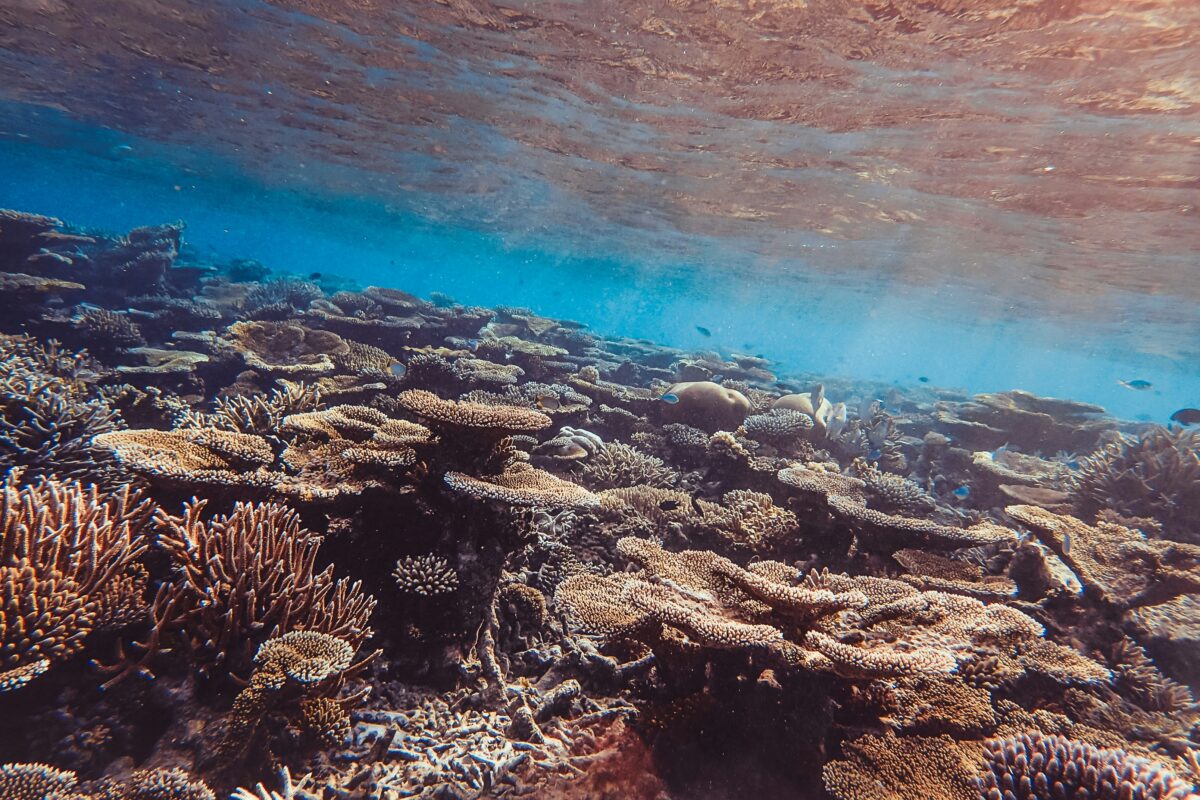The effects of climate change are threatening the world’s coral reefs, prompting scientists and governing bodies to propose a number of approaches to restore and increase the resilience of these vulnerable ecosystems. Warming sea temperatures increasing the risk of coral bleaching, rising carbon dioxide levels causing ocean acidification which hinders coral’s ability to form their skeletons, and harmful human activities such as pollution and destructive fishing practices all pose significant threats to the success of coral ecosystems. Therefore, strategies such as selective breeding of corals, genetic engineering, and other preventative methods have been implemented to mitigate the effects of climate change on these coral reef ecosystems.
Scientists often search for ways to both restore coral and increase their resilience against future threats. One restoration strategy is outplanting, or growing coral in a nursery and then replanting it in a damaged reef. A 2021 study by Kaufman et. al found that coral samples taken from warmer reefs were more resistant to extreme heat events and recovered faster from lesions than other coral, suggesting that outplanted coral sourced from warmer reefs could help strengthen heat resistance in cooler ecosystems. During bleaching events in the study, coral lesion recovery stopped entirely, meaning the heat resistance of coral has major implications for the general physical health of the coral, even beyond the initial damage of bleaching. The combined benefits of this restoration approach have the potential to bolster the health of newly restored ecosystems and strengthen them against future environmental threats.
Other researchers have sought to investigate exactly why some coral are more resistant to heat than others, and how this knowledge can be applied to improve restoration efforts. Boston University’s Davies Lab recently published a paper, Fifer et. al, studying coral reefs in Mo’orea, French Polynesia following a bleaching event. They found that coral’s resistance to and survival of bleaching is a heritable trait determined by several different genes. This study also determined that the specific genetic factors that control coral’s ability to adapt following marine heat waves varied between habitats. The researchers suggested that this may be the result of the different pressures put on various habitats by heat waves or the high level of genetic diversity in the population, but regardless, it demonstrates the complexity of the genetic basis for heat resistance, suggesting that there is no “one-size-fits-all” solution to these issues.
One 2024 laboratory study by Humanes et. al examined the potential to selectively breed for heat-resistant traits in coral as a potential method of assisting or facilitating coral adaptation to extreme temperatures. They found that the heat resistance trait varies within species, meaning that it can be selected for while still maintaining species diversity in an ecosystem. However, selection must be done through a series of heat exposures, which is a time consuming process because the selected corals must be exposed to heat for extended periods. This concept is also being put into practice in studies conducted by the Australian government in the Great Barrier Reef. Their research will also explore the possibility of artificial selection among coral larvae. By putting a large portion of larvae under heat stress, they will attempt to isolate the more resilient individuals. This could help scientists create larval populations more resistant to bleaching, which could be subsequently released into the ocean for coral restoration efforts.
Some scientists have also pursued genetic modification of corals as a potential solution. However, there is still a relative lack of knowledge about the specific genetic factors that contribute to coral’s resistance to high temperatures and bleaching, because it is both controlled by a number of different genes and expressed in a number of different ways. The release of genetically engineered organisms into the wild also raises a number of scientific and ethical questions about the role of this technology. For example, using gene editing to strengthen heat resiliency traits may have unintended effects on other genetic traits. Introducing such a coral could also disrupt an existing ecosystem. Due to these potential effects, conservation organizations and government bodies have varying positions, some hesitant to place these genetically modified coral into the wild.
Instead of seeking to modify coral itself, other researchers have opted to investigate the potential for its symbiotic algae to support heat resistance. In a 2023 study, a group of researchers exposed these algae to extreme heat in order to isolate a group of symbionts that could tolerate particularly high temperatures. These algae were then introduced to bleached coral for a period of two years, where they were found to both increase recovery time and tolerance to heat waves. Previously, similar studies found that heat-resistant algae inadvertently decreased coral growth, which could pose a potential risk to coral ecosystems, but the coral in the 2023 study did not have the same issues. However, this method still requires further study and application to determine its efficacy in wild ecosystems, not solely in a lab setting.
While many of these strategies are designed to prevent coral bleaching, ocean acidification also poses a significant threat to the health of coral reefs. The issues of coral bleaching and ocean acidification are interlinked because acidification, which weakens coral’s skeletons, also decreases their ability to recover between the bouts of extreme heat that cause bleaching. However, protecting reefs against ocean acidification poses some challenges, because while coral bleaching is associated with specific, often seasonal warming events, ocean acidification is caused by rising absorption of carbon dioxide by the ocean, and remains largely consistent throughout the year. One paper suggested that some of the strategies used for coral bleaching could be applied to ocean acidification, as some species of coral are more resistant to acidification than others. This is complicated by the fact that some coral with high resistance to acidification may have low resistance to extreme heat, or vice versa. Therefore, careful consideration of the available research and the most significant threats to individual ecosystems is necessary for making restoration decisions.
A less research-intensive method to address acidification on a local level is the removal of other contributing factors like pollution, sedimentation, and runoff, which can help to mitigate impacts on individual ecosystems. It has also been found that seagrass beds can absorb excess carbon dioxide and reduce the effects of acidification on nearby reefs. Areas with seagrass or more resilient coral should be prioritized when designating Marine Protected Areas. Even when restoration is not taking place, knowledge about corals’ resistance to heat or acidification can be helpful when making conservation decisions. Preventative measures are also possible, particularly in areas where damage to reefs is exacerbated by local issues like runoff, habitat disturbances, or pollution. Though this doesn’t change the global rates of ocean warming or ocean acidification, removing local stressors may increase coral’s resilience against and ability to recover from these global issues. The major threats to coral reef ecosystems – coral bleaching and ocean acidification – are ultimately tied to global climate change, and will continue to be a subject of research as their effects progress. As individual ecosystems experience these impacts differently, unique approaches may be necessary based on the ecosystem’s specific needs, as habitats and the knowledge in the field continue to evolve.
Sources:
Albright, R., & Cooley, S. (2019). A review of interventions proposed to abate impacts of ocean acidification on coral reefs. Regional Studies in Marine Science, 29, 100612.
Breeding temperature tolerant corals for reef restoration and adaptation. AIMS. (2023, November). https://www.aims.gov.au/research-topics/featured-projects/reef-spawning-research-aims/breeding-temperature-tolerant-corals-reef-restoration-and-adaptation#:~:text=Ocean%20temperatures%20are%20getting%20warmer,experimental%20lines%20of%20coral%20offspring
Chan, W. Y., Meyers, L., Rudd, D., Topa, S. H., & van Oppen, M. J. (2023). Heat‐evolved algal symbionts enhance bleaching tolerance of adult corals without trade‐off against growth. Global Change Biology, 29(24), 6945-6968.
Cornwall, W. (2019, March 21). Researchers embrace a radical idea: Engineering coral to cope with climate change. Science. https://www.science.org/content/article/researchers-embrace-radical-idea-engineering-coral-cope-climate-change
Fifer, J., Speare, K. E., Leinbach, S. E., Hendricks, S. F., Davies, S. W., Rose, N. H., … & Strader, M. E. (2024). Genomic signatures of coral adaptation and recovery following a mass mortality event. bioRxiv, 2024-09.
Humanes, A., Lachs, L., Beauchamp, E., Bukurou, L., Buzzoni, D., Bythell, J., … & Guest, J. R. (2024). Selective breeding enhances coral heat tolerance to marine heatwaves. Nature Communications, 15(1), 8703.
Kaufman, M. L., Watkins, E., van Hooidonk, R., Baker, A. C., & Lirman, D. (2021). Thermal history influences lesion recovery of the threatened Caribbean staghorn coral Acropora cervicornis under heat stress. Coral Reefs, 40, 289-293.
Mcleod, E., Anthony, K. R., Andersson, A., Beeden, R., Golbuu, Y., Kleypas, J., … & Smith, J. E. (2013). Preparing to manage coral reefs for ocean acidification: lessons from coral bleaching. Frontiers in Ecology and the Environment, 11(1), 20-27.New treatment could enhance coral heat-tolerance and buy time for threatened reefs. Newsroom. (2023, November 2). https://www.unimelb.edu.au/newsroom/news/2023/november/new-treatment-could-enhance-coral-heat-tolerance-and-buy-time-for-threatened-reefs

